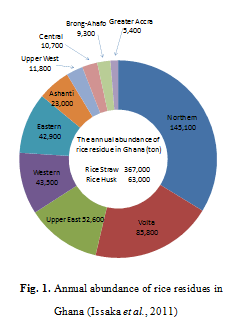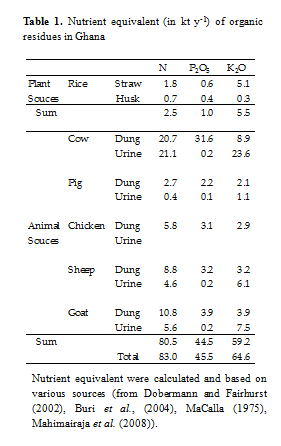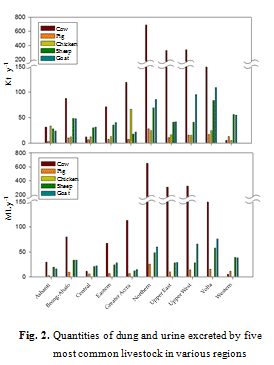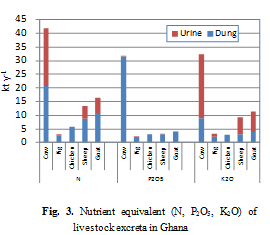Indigenous organic resources for improving soil fertility in rice systems in Sub-Saharan Africa
Description
Low soil fertility in Sub-Saharan Africa (SSA) has resulted in a decrease in rice production. It was also found that small-scale farmers do not have enough purchasing power to afford sufficient amounts of commercial inorganic fertilizers to replenish soil fertility. Thus, to increase agricultural productivity without spending much on fertilizers, easily obtainable and low-cost indigenous resources were examined. This study was aimed to quantify the abundance of various indigenous organic resources, estimate the amount of fertilizer equivalent, and map the distribution of resources in Ghana, SSA. The survey was conducted to investigate the availability of indigenous organic resources for use in agriculture and determine the amounts of plant- and animal-derived nitrogen (N), phosphate (P), and potassium (K). Moreover, this study was aimed to improve rice productivity pursuant to the goal of the Coalition for African Rice Development (CARD).
It was found that various indigenous resources from agricultural wastes such as rice straws and rice husks could be used for rice systems in Ghana. These residues were abundant in Northern, Volta, Upper East, Western, and Eastern regions where large amount of rice was produced (Fig. 1). Total rice straw and husk produced as waste in Ghanaian rice systems was 430,000 tons. These contained N, P, and K elements with nutrient equivalent (in tons) of 2,530 N, 990 P2O5, and 5,460 K2O, respectively (Table 1).
Various livestock excreta including dung and urine were also abundant, particularly from cows followed by excreta from goats. Amount of excreta differed among regions. Cow and pig excreta were largely produced in Northern, Upper East, and Upper Western regions. Poultry manure was ample in Ashanti, Greater Accra, and in other municipalities and cities (Fig. 2). Livestock excreta produced in Ghana were calculated to contain 80,500 N, 44,500 P2O5, and 59,200 K2O (total nutrient equivalent, in tons). Phosphate was found in all livestock dung (Fig. 3). (It should be noted that the calculated composition of fertilizer in each resource was based on previous documents and statistics data of the Ministry of Food and Agriculture of Ghana published in 2007.)
The estimated quantity of indigenous organic resources differed among regions; thus, resources should be optimized for use in the host areas. For example, in the Northern region where rice cultivation is most prominent, adding rice straw into the rice cultivation system would cover approximately 20 percent of N and P, and most K requirement of the soil compared to applied chemical fertilizers. Also, based on total estimated organic resources from livestock, if only 20 percent of these resources were utilized, it could replace the requirement for chemical fertilizer in rice cultivation system for the entire Northern region. Furthermore, development of composting techniques is required for sustainable and effective application of these organic resources. Meanwhile, it has been noted that grazing livestock excreta (dung and urine) were difficult to manage; hence, effective methods for its collection and transportation from the sources should be investigated prior to its use. In addition to the aforementioned observed resources in Ghana, other organic resources such as human excreta, sawdust, and oil palm shells are also available and may prove useful. Therefore, further studies on the abundance and usefulness of these resources should be considered.
Figure, table
- Affiliation
-
Japan International Research Center for Agricultural Sciences Crop, Livestock and Environment Division
- Classification
-
Research
- Research project
- Program name
- Term of research
-
FY 2010 (FY 2009-FY 2011)
- Responsible researcher
-
Tobita Satoshi ( Crop, Livestock and Environment Division )
KAKEN Researcher No.: 30450266Issaka Roland ( Soil Research Institute, CSIR, Ghana )
Buri Moro ( Soil Research Institute, CSIR, Ghana )
Fukuda Monrawee ( Crop, Livestock and Environment Division )
Nakamura Satoshi ( Crop, Livestock and Environment Division )
ORCID ID0000-0002-0952-5618KAKEN Researcher No.: 00749921 - ほか
- Publication, etc.
-
Issaka, R.N., Buri, M.M., Tobita, S., Nakamura, S., Owusu-Adjei (2011): Indigenous fertilizing materials to enhance soil productivity in Ghana, In “Soil Fertility”, pp. 119-134, In Tech Press, Rijeka, Croatia
- Japanese PDF
-
2011_05_A4_ja.pdf149.81 KB
- English PDF
-
2011_05_A4_en.pdf162.39 KB




